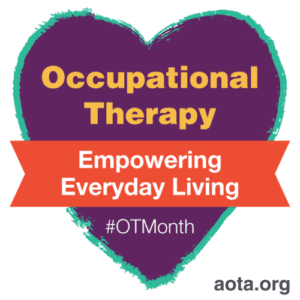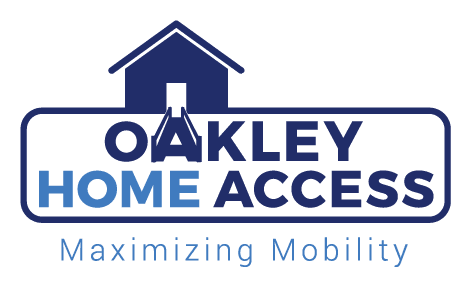OT Month & Where To Start With Home Modifications

April is National Occupational Therapy Appreciation Month. In appreciation, we want to highlight our three occupational therapists as well as all of our OT partners out in the community working to keep clients safe at home. Occupational Therapists are experts of the human body and the way in which we interact with an environment. From the moment our assessors enter the home, they are evaluating the client and environment to see potential barriers to success. We observe the way our clients navigate stairs, where they hold onto for support in the house, and how much stamina they have. All of these observations and more help to guide our decisions on the right products and modifications for each specific client.
When Justin Oakley and Mike Vieira founded Oakley Home Access, they knew the value that occupational therapists bring to this field. Our model ensures that clients are getting personalized, function-based recommendations from our occupational therapists, who are the experts of the human body and then in-turn having these products installed by our technicians, who are of course the masters of the physical environment. Alex DeNoncour and Daniel Lynch are two passionate occupational therapists here at Oakley Home Access that are always looking to collaborate with patients, their family members, and their occupational therapists to provide the most appropriate solutions for maximizing mobility.
One of the common concerns we get from clients is, “I don’t think I’m ready for a stairlift or a ramp at this time, but I do have some concerns in the house. Where should I start?”. This inquiry aligns perfectly with the mission of OT, to maximize health, well-being, and quality of life for all people, populations, and communities through effective solutions that facilitate participation in everyday living. These solutions very often are far more conservative than our clients may think.
Aging in place is often looked at as a large-scale renovation to make one’s home completely handicap accessible. What many people do not realize is that Aging in Place can be a continuum of small and conservative measures to help prevent falls and traumatic events. Our team of dedicated professionals are experts at recommending minimally invasive modifications that are affordable and maximize function. In the remainder of this blog, we will discuss some great starting points for those who may be interested in Aging in Place. The two areas of the home we want to prioritize are the bathroom and anywhere there are stairs. These are the most frequent areas of the home where falls occur. For a client who is only having minor difficulty, these areas of the home can be easily modified to maximize function and prevent falls.
When asked to describe the average bathroom we see in our daily evaluations, it includes a combination tub/shower unit, glass shower doors, and a 15” standard toilet. Without making any major modifications, we can assist to make this bathroom more functional and help to prevent falls. The Oakley Home Access Conservative Remodel typically includes recommendations such as…
- Removing Glass Shower Doors: Removal of these doors will allow a client to have full access to the entrance width of the shower. The doors themselves are dynamic and many clients fall as a result of the glass shower doors opening or sliding unexpectedly or while stabilizing themselves on the door. These doors can be replaced easily with a curved mounted shower rod and a decorative shower curtain.
- Strategically Placed Grab Bars: Assessed for by our skilled team, we can recommend grab bar placements for you that will ensure stability while stepping over the tub wall. These will be professionally installed and set to proper heights for the needs of the client.
- Mobile Shower Head: A Mobile shower head will allow a client who sits for their showers to control the direction of the water, and ensure a more enjoyable and comfortable shower.
- Raised Toilet Seat: Increasing the height of the toilet to 17-18 Inches will allow clients who struggle with transfers to stand up more independently. Many times we compliment these seats with grab bars by the toilet for extra stability.
Given our location in New England, it is very common to have several steps to enter the house, and very common to have multiple level houses. Very often we see homes where all the bedrooms are located upstairs, and the only bathroom may be upstairs. This is true for many colonial, raised ranch, and cape style homes. While a client may be doing these stairs successfully, the addition of railings and handrails can help to prevent an accidental fall.
- Hand Railings for Interior Stairs: Having at a MINIMUM, a unilateral handrail for all sets of stairs is essential. We prefer rounded handrails that allow our client to have a firm grasp. If the staircase is a proper fit, we always recommend and prefer bilateral hand railings.
- Railings on Exterior Stairs: If the main form of egress from the home is via the front or side stairs, we recommend having a sturdy bilateral railing system to provide a handhold for navigating those stairs. It’s equally important to inspect the railing system you already have. After 50 years of home-ownership, there is a high likelihood that the existing railings may be ready for replacement.
These modifications are just some of the conservative measures we recommend as an entrance into Aging in Place. These modifications are minimally invasive, affordable, and a great investment into long term health and safety. One thing we cannot stress enough is that Aging in Place is not “One Size Fits All”. It is a strategic and tailored set of recommendations and modifications for each client. That is why at Oakley Home Access, we utilize Occupational Therapists and Certified Aging in Place Specialists to complete our Free Home Safety Assessments.
Thank you to all the clients out in the community who have entrusted us with your goals to age in place. One of our biggest passions is modifying homes for fall PREVENTION. While the majority of our work is in response to a decline in mobility or fall, we look forward to helping more clients modify their home before they have a fall.
To schedule your Free Home Safety Assessment, reach out to our office at 401-429-3882 or submit an online inquiry at www.oakley homeaccess.com.
